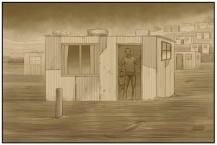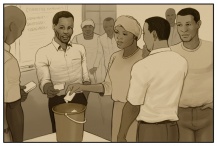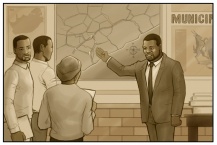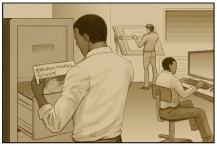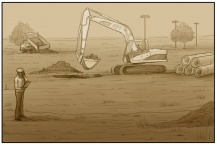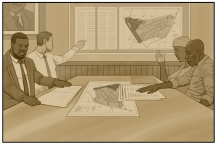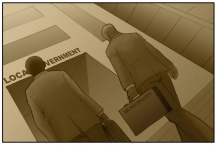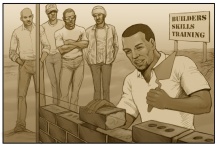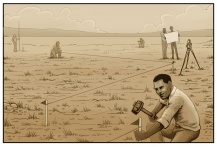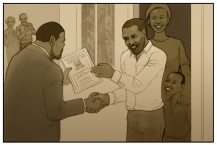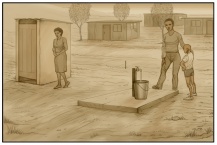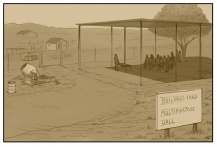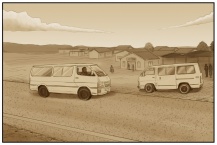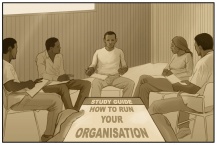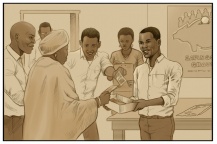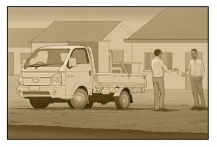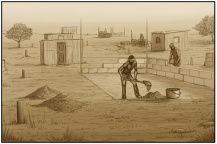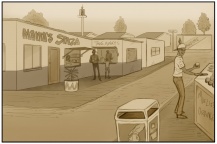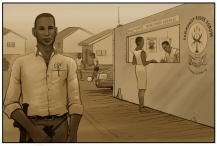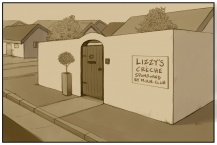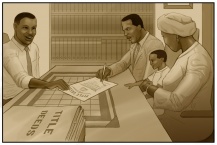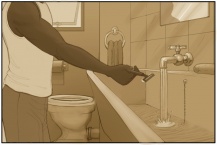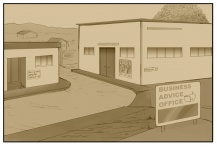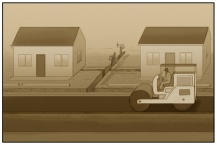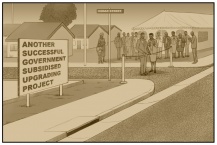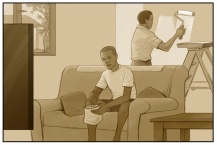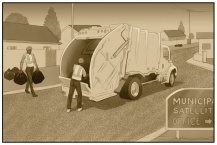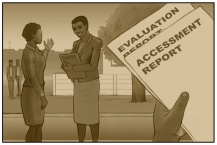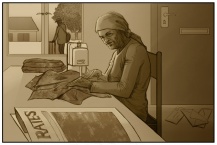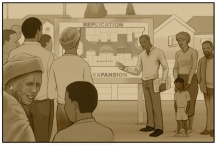Pamela's story

This is the story of how Pam and her family and friends were involved in building houses and a neighbourhood for themselves.
Story 1: Bulk Preparation
It starts with Pam and some of her friends starting to save for their future housing needs, and then, through the contacts that they made, finding land that a church was willing to donate to them. It also identifies all the processes that they needed to follow to get this land ready for development, including getting planning and environmental approvals.
Initiation and management
My name is Pamela, or Pam for short, this is the story of how I build a home for myself and a neighbourhood for my family, my neighbours and my friends.
The story started about 10 years ago when I lived with my partner Temba and our two small children in a two room corrugated iron shack in a Squatter Camp, an informal settlement on the edge of Eden Ridge Township, a suburb of Dale View, a medium sized town in South Africa. We had to rely on family in the nearby four roomed houses for water and a toilet; or sometimes we just used the bush.
Temba used to work at a local supermarket and I did a little sewing with my mother-in-law to get a little extra money.
I had heard for years about plans the municipality was making for moving our, and other, informal settlements to a new RDP housing project beyond Eden Ridge Township. But every time there was a community meeting to report back on progress there was always another excuse, like that the land was owned by the prison service and it was taking longer than expected to transfer it to the municipality.
In the end, the municipality did manage to organise a new housing project in that area but I do not know how the people who were allocated to this new RDP housing project were identified. All I know was that none of the people I knew were lucky enough to get one of those houses.
At the time, like many of us in the Squatter Camp, I was a member of the local Congregation Church. The church wanted to help people like us, who lived in informal settlements, but they were not sure how they could do this.
About 9 or 10 years ago a flood washed away about 15 of the shacks in Squatter Camp. My family was lucky not to be badly affected. These flood victims were desperate, and had nowhere to go.
The Congregation church owned a large piece of land about 5 kilometres outside Eden Ridge Township. Prior to the flood the church had participated in an emergency housing project which was organised by the municipality. The church had agreed with the municipality that in the event of a housing emergency, an old unused sports field on its land could be used to house the people affected by emergencies (like the flood) on a temporary basis. About 15 of those people affected by the flood moved to this temporary relocation point on the Congregation Church land.
There was very little planning done for these flood victims and they just had to do the best they could under the circumstances. The Municipality was supposed to find alternative land for these flood victims, but it was clear to all involved that this was not going to happen quickly. The church also did not want an uncontrolled settlement to grow on their land, so they set up a committee (with the municipality and flood victims) to find a better long term solution for these temporarily displaced persons.
Visit Organising for more information and discussion on this topic.
Bulk organising
A year before this flood, a few of my neighbours and I visited a savings scheme we had heard about in one of the other townships in Dale View. Here we heard about a Savings Schemes Network, a membership based organisation with groups in many part of the country that encouraged and helped people like us to organise ourselves into small savings schemes so we could start to save and organise to address our own development needs. We also heard about Development Support Organisation, an NGO that helped these savings schemes.
When we returned to Squatter Camp, about 20 of us started our own savings scheme – “We Can Savings Scheme”–and joined the Savings Scheme Network. We Can Savings Scheme members used to meet monthly and each of us deposited about R50 into a bank account. I was elected the secretary of the savings scheme. The scheme’s main objective was to save and plan for housing, but we were also able to help some of our members with some of their other needs (like getting ID documents, and supporting others to get their children into the local school).
After a year, there were 3 other savings schemes in other parts of Eden Ridge Township, each with between 15 and 30 members, who also started schemes because they also wanted houses.
Visit Organising for more information and discussion on this topic.
Bulk land
After the flood victims had moved onto the Congregation Church Land, I met with the leadership of Congregation Church and explained what the savings schemes were doing. The church liked the fact that the saving scheme members were not waiting for government to give them houses and were taking matters into their own hands.
After a few months of negotiating, the 4 savings’ schemes (the scheme I was in and the 3 others from Eden Ridge Township that had started at that time) entered into a memorandum of understanding (MoU) with the church, that we would work together to see how some of the vacant Congregation church land could be donated to members of the 4 savings schemes and used for housing.
Many other people heard about the agreement our savings schemes had reached with the Congregation Church, and over the next few months more savings schemes were established in Eden Ridge Township.
When Development Support Organisation, the NGO supporting the Savings Scheme Network, heard about this MoU, they visited our schemes and the church and advised us to pilot what they called a Managed Land Settlement project, on the Congregation Church Land. A planning working group was established that was made up of the church and savings scheme leadership and Development Support Organisation to start planning for this Managed Land Settlement Pilot Project. I was elected into this working group.
One of the first things the planning working group did was to visit the municipality to see how the municipality could help us develop on this church land. The Municipality told the planning committee that they could not provide too much support as the land did not belong to them, and that the municipality had other priorities.
The good news we heard at this meeting was that the area where the church land was located, was part of the municipality’s long term Integrated Development Plan and was just on the urban edge, on land earmarked for residential development as part of the local Spatial Development Framework. This meant that we would not have to spend time motivating for the area to be incorporated in the municipalities’ long term plans.
Visit Land and Planning for more information and discussion on this topic.
Bulk planning and environment
When we met with the Municipality they also told us that the church, as land owners, had to arrange to submit plans to the municipality to get approval to develop this church land as a managed land settlement project.
As a member of one of the savings schemes that were allocated to the church land (see the section on bulk allocation below) we agreed that we would use half of our savings to pay for some basic plans to be done. Development Support Organisation also donated some money and appointed a town planner, an environmentalist, engineer, and land surveyor that they had worked with before in other parts of the province who had some understanding of the managed land settlement approach.
The town planners held a workshop with members from the savings schemes and we all agreed on a broad framework layout for the church land. The planners called this plan a ‘sub divisional area plan’. The plan showed were the main access road was on the church land as well the where the 5 blocks would be located next to this access road.
The church would retain a piece of land for its own use. The space where the people who were affected by the flood were allocated to, would also be developed in a similar way as the other blocks. A new piece of land would be set aside on the church land for a new temporary relocation area that would be used to house people in potential future emergencies on a temporary basis. The understanding with this plan is that this land would only be used only if the municipality knows where these people will be housed in future, on a more permanent basis.
The town planners, appointed by Development Support Organisation, used the draft framework plan we had developed and applied to the municipality for this area to be rezoned from institutional (church) zoning to a sub-divisional area. This was a rezoning application to the municipality, based on the Land Use Planning Ordinance. The sub divisional area plan included the following information: • The broad spatial framework plan showing the main access roads and superblocks; • The number of residential plots that would be built in each superblock (the residential density) • The zoning that would be used for each block or portion of land within the sub divisional area.
The town planners had to zone the superblocks as a special zone for incremental settlement. This would allow us to build incremental houses on the land. If the land was zoned as residential we would not be able to build temporary houses. It was also indicated in the sub divisional plan motivation that in future the intention would be to zone the residential areas a residential zoning (for normal suburban residential areas.
Our application had to motivate for why we wanted to go the route of a rezoning like this, rather than the township establishment process which is the route normally followed. For us, this was one of the legal options available to us for a managed land settlement project; we took the advice from our planners in selecting this particular rezoning plan. We also had to detail the “basket of rights” - rights, densities and feasibility of providing services, public open space, etc.
The application had to be advertised for comments from the public. We were told at the time that it would take up to one year to obtain approval. Because of this we could not settle until this approval was obtained. At first we thought we might have to wait until a general plan was approved for the superblocks, but instead we managed to get permission to settle on the land with a draft general plan. Luckily there were no objections so we were able to get approval in less than a year. The Municipality did not have to submit the draft general plan to the surveyor general at this stage as we were not creating formal residential erven (or plots) at this stage. Once the framework layout (or sub divisional area plan) for the church land was developed, the environmentalists, that Development Support Organisation appointed for us, had to produce an environmental study and a heritage impact assessment also had to be carried out as there was uncertainty with regards to graves in the area.
Both the Environmentalists and Town Planners (as part of the rezoning and land development process) had to conduct a public participation exercise. The municipality and the Department of Environmental Affairs agreed to cooperate and allow the church, as land owners, to conduct one public participation process for both the planning and the environmental approval processes. This involved putting an advert in the paper, holding a public meeting and putting notices up on site, informing people about the development and giving them an opportunity to comment.
Luckily, given the fact the main neighbouring land owner was the municipality; there were no objections to the development. This was an important moment for us because it meant that our settlement had some legal recognition. Development Support Organisation explained that having the area approved by the municipality as a sub divisional area and with an incremental zoning meant that we were secure as our settlement had been “legally declared”. This meant that the municipality could “see” us, instead of us being informal.
Visit Land and Planning for more information and discussion on this topic.
Bulk services
The bad news we heard from the municipality when we first met with them, about developing the church land, was that there was no bulk water and sewerage system in the area, and the likelihood was that there would be no development in the area at least within the next 5 to 8 years. The process would have to wait for the municipality to slowly, year by year, expand its bulk services infrastructure out towards the church land.
The church knew that there was quite a good borehole in the area that had not run dry in living memory. We agreed, as savings schemes, that we would be prepared to use this water for communal standpipes if it was found to be suitable. We were also prepared to consider alternative sanitation options like composting toilets.
Visit Services and Facilities for more information and discussion on this topic.
Bulk access
Although the church land was 5 km’s further out of town, it was also (as per the municipalities Integrated Development Plan and their strategic transport plan) part of a future development corridor that linked Eden Ridge Township and some communal villages and lands that started about 20 kilometres further out of town. This road was already, at the time, fairly heavily trafficked with taxis and cars. There was also a new proposed industrial area nearby, that the municipality was considering developing as part of its Special Development Zone plans.
Visit Access for more information and discussion on this topic.
Bulk allocation
As part of the Memorandum of Understanding (MoU) between the savings schemes and the church it was agreed that only the first 4 savings schemes would be able to move onto the church land. It was agreed that the church land would be divided up into 5 blocks, with each of the savings scheme allocated to one of the blocks. The 5th block would be left for the original flood victims who were already on the land in the temporary relocation area. Each block would then be able to determine how they could develop ‘their’ block. The allocation list was therefore effectively made up of members of each of the savings schemes.
The outer boundaries of each block was planned so that each block was just big enough to accommodate all the savings scheme members at a plot size that was acceptable to the members. The good thing about this arrangement was that when we all moved from Squatter Camp to Twin Oaks we already knew each other from working together in the ‘We Can Savings Scheme’.
Each savings scheme was asked to give their block a name. As ‘We Can Savings Scheme’ we decided to call our block Twin Oaks as it had two oak trees growing on it. We also gave this new community the name ‘Bongweni’ which means ‘the place where people have pride’.
While the savings schemes that were allocated to the church land were planning and getting ready to move onto the land, the other savings schemes that had not been allocated to the church land continued negotiating with the municipality to try and find some land for them to do something similar to what we were doing.
These were quite protracted negotiations, as there were many people that the municipality had to find land for, but after about a year and a half these other savings schemes agreed with the municipality that some of them would be allocated to a small part of the municipal land, which was next to the church land that we had been planning for. The Municipality would use the rest of this land it owned next to the church land for other people from their waiting list and informal settlement relocation plans.
Visit Tenure for more information and discussion on this topic.
Bulk financing
It was very difficult for the savings schemes and the church to find money for these preparation activities. If it was not for the generosity of the church in donating the land, and the Development Support Organisation in donating funds for the necessary planning and studies, the pilot managed land settlement project on the church land would have likely not have been possible.
There were also sympathetic and open minded officials within the planning department of the municipality, who gave valuable advice and helped get the plans through the complex bureaucratic system.
As savings schemes we decided not to use our own savings for some these studies and rather decided to use our savings for putting in some of the services during the next basic product stage.
The provincial department of human settlements also commissioned an independent study to draw lessons from the experience of getting this land ready for development (see analysis and review in phase 5 for more on this).
One of the key recommendations coming out of this study was that government needed to give far more attention to funding the feasibility and preparation phases. Being unable to access land on which incremental settlement (and other forms of settlement development) can occur is one of the main bottlenecks in being able to address the land and housing challenges of the country.
The municipality also picked up on some of the lessons emerging from this study and decided to change its approach to the development of the municipal owned land that was adjacent to the church land from a conventional RDP housing type approach that would take years to implement, to a managed land settlement (MLS) approach similar to our MLS pilot project on the church land.
For the municipal owned land most the money for much of their preparation phase came from the Municipal Infrastructure Grant that was spread over a number of years.
Visit Financing for more information and discussion on this topic.
Story 2: Basic Product
Pam and her friends from the savings schemes now have approval to undertake a Managed Land Settlement pilot project in Bongweni on the church land.
Attention now shifts to planning what the blocks will look like, how tenure will be secured and how to get some basic level of services onto the land.
Basic organisation
One of the most exciting times of the whole development was when I heard that the municipality had approved the development of the church land. It had taken us about a year from when the church and savings schemes signed the Memorandum of Understanding (MoU) to when the municipality approved the framework plan (or sub divisional area plan) that created the superblocks.
During this time, while the planners, engineers and other professionals were doing all the things outlined in the Bulk Preparation phase, our savings schemes had not been idle.
We managed to arrange for some of our members, including my partner Temba, to attend a training course in construction skills, like pipe-laying and bricklaying so that we would have labourers from our community to work on any construction work that was needed in future. This was paid from the Department of Labour.
While we were still living in Squatter Camp and other areas of Eden Ridge Township, the Development Support Organisation organised a skills training course for our savings schemes on leadership skills and how to run meetings, get mandates and report back to members. We gained some useful basic knowledge at these training sessions that helped us run our organisations more efficiently.
Visit Organising for more information and discussion on this topic.
Basic planning / demarcation
The Church, on the advice of Development Support Organisation, arranged for a professional land surveyor to mark out the outer boundaries of the blocks as per the sub divisional area plan that was approved at the end of the bulk preparation phase.
One of the most uplifting experiences I had throughout the whole development process was when Temba and I (and the other savings scheme members) participated in a two day workshop, organised by Development Support Organisation and the planning working group that we established in phase 1,to develop layout plans for household plots within each of the blocks. We had organised taxis to take us to this workshop which happened at Congregation Church on the church land.
Development Support Organisation had produced a manual on how to layout plots, which they presented at the workshop. This was the first time that I was able to really think about what type of neighbourhood I would like to live in. I was able to think about how to make my dreams come true.
- At the workshop we broke up into groups according to our savings schemes/ blocks.
- We then walked to our actual blocks and looked around to see what was there. Big flags had been placed at the corners of the superblocks so we could see exactly where the blocks were.
- We then went back into the church hall, and brainstormed what type of environment we would like to have. These ideas were presented back to the other schemes and other role-players present and comments and suggestions were made.
- We were then given a large aerial photograph of our piece of land and used tracing paper and paper squares, cut to the size of an average house on the aerial photograph, to look at different ideas as to how we would like our houses to be laid out in the block.
After the workshop the planners contracted by Development Support Organisation copied the provisional house positions we had shown on the aerial photograph. They then used this to make rough plot and street plans on another large aerial photograph.
A pegging task team, that included Temba, was elected and came back later and marked out the plots on the ground, using a tape measure, pegs and string. A few minor adjustments had to be made so that things like storm water gullies did not run through the middle of a person’s plot. This opportunity gave Temba much more confidence that he would be able to tackle almost any challenge that came to him in future.
Visit Land and Planning for more information and discussion on this topic.
Basic tenure
At the end of the bulk preparation phase the church land was rezoned to a sub divisional area with special zoning for incremental settlement. This already started to give us tenure security as the land was properly planned and shown in the municipality’s plans as an area where people could live.
Now that we knew who was going to be staying in the different blocks in the Bongweni community, the savings schemes began to discuss what people would be able to do on the land. Development Support Organisation held a few meetings with the savings scheme members to discuss this as well as what rights they would have on the land, how they could be protected from eviction and how land use would be administered.
It was agreed that Congregation Church would initially keep ownership of the land and in future, when government housing subsidies were obtained, those people that wanted individual ownership could then get their plots transferred into their names. But the church did not want to play a significant role in managing people’s rights and uses. It was important to them that the number of houses to be built in the area, should be limited to the number of plots decided upon Prior to anyone moving onto the land in the Bongweni community, the planning working group with the support of Development Support Organisation conducted a survey to determine what rights people expected to get once they settled on the land. This was presented at a workshop. The following points came out of this exercise:
- Everyone agreed that we have a right to settle on the land and we called this a an occupation or a use right
- Everyone wanted to be able to build a house and we called this the right to make improvements on the land. We were less sure about whether building plan approval for a formal house was needed (i.e. one made from bricks)
- eople wanted to be able to pass on their land to their children and we called this the right to bequeath our land
- Everyone would need to pay a small fee to the savings scheme to administer things. We were lucky that the Church, as land owners, did not require any fee or rental. We agreed that payment of this charge (to the savings schemes)would be one of the obligations that come with the rights to occupy/use, make improvements and bequeath. People agreed that the savings’ scheme has the right to make this charge.
- People wanted to be able to run small businesses on their sites but we agreed that they would need permission first, not from the municipality necessarily but, firstly from their block committee (which was created from the same people as the original savings schemes), and then from the church. Usually the church would ‘rubber stamp’ the block approval, unless there was a dispute of some sort, in which case the church would try and mediate. These are use rights. While the first right is a right to residential use we understood that this right is for non-residential, economic uses.
- We were undecided about whether people should be allowed to sell their properties but in the end we agreed that for as long as the church owned the land, it would be unfair to make a profit if you need to move. However, if you have built a house then you have a right to recover the costs of that. This made us realise the importance of administering tenure rights, otherwise people might land up being insecure because things become unclear. We understood this to be all about processes and procedures, rules and monitoring.
- A register would be kept of who has rights and obligations and where they have them. The register would build on the allocation list (see section on bulk allocation in bulk preparation phase) and contains names and a plot number so that we have a way of identifying who has rights and where they have them
- We also came up with some neighbourhood rules – quite like house (or block) rules of occupation – that looks at issues such as what to do if you want to rent out a room or a backyard structure, or if you want to put relatives in your place if you need to leave). We decided to also put dispute resolution procedures into our resident’s association rules in case there are conflicts. We felt that the Congregation Church might be able to play a role in supporting conflict resolution, but we decided we would develop the procedures over time.
- We also agreed that the occupation register would need to be managed and that the rules would need to have a clear authority ‘person’ or structure to back them up. So we agreed that we would make this the job of the residents’ committees of the blocks.
- The register would record both the husband and wife (or co-habitors if not married) so as to ensure that both the man and women would have tenure security. Children’s names would also be kept on the register.
- Development Support Organisation clarified for us that these two things together – the register and the procedures – will give meaning to what we call tenure security, as long as they have support and legitimacy.
- However, some people in the workshop were unhappy that they would not be receiving a piece of “paper” of their own proving that they have the right to stay on the land, so we agreed that we would ask the Congregation Church to write a letter to each household saying that they agreed to their settlement on the church land, provided that no additional plots were demarcated and more households moved into the block.
See the section on aided local tenure administration in phase 3 (aided self development) to see how we managed our local tenure system for both the plots and the common space.
All households signed the occupation register kept by the residents committees of the blocks just before we moved onto the land and the church gave them their occupation letter. We had a big party after this was done. It was a big milestone for all of us who had been working for so long on this project. These celebrations played an important part in keeping us all involved and motivated to keep going thought this long process.
Visit Tenure for more information and discussion on this topic.
Basic services
At a workshop, organised by the engineering consultants appointed by Development Support Organisation with the savings’ schemes/ blocks; it was explained that waterborne sewerage would not be possible as there was no bulk infrastructure.
The following services were agreed to for all the blocks as a start:
- One composting toilet for every 4 houses (the engineers called it a double vault urine diverting composting toilet).
- At least one communal standpipe (or tap) per block with soak away pit for waste water coming from the tap (or within 200 meters from the furthest house). The water would come from a borehole on the site.
- Lined storm water drainage at the main crossing into the block. No work would be done on the roads at the start.
The savings schemes all agreed to use their savings money to put in these communal water pipes, communal toilets and lined storm water.
Development Support Organisation later helped us negotiate a big discount for a solar light for each communal toilet.
A local gardening club also agreed to provide a zero interest loan to the savings schemes to provide a package that included poles, corrugated iron roofing sheets, gutters and a water tank for each house. Households interested in the package took out loans, at very reasonable interest, from the savings’ scheme to get this package. Most households took this loan and the material was stored in a shed at the church. Our family took out one of these loans and we started to pay this loan back even before we moved into the houses. (See the section on Aided resource mobilisation for more on this)
There was concern, from the start of discussions, about communal toilets - over who would clean and maintain the toilets. I knew, along with the other women, that this job would probably fall to us, and we were a little worried about how many activities we were taking on, throughout the development process. But in the end this did not become a problem as, after about 6 months, one of the households that were doing agricultural activities on nearby land (see the ‘self growing’ section, in phase 3 aided self development) arranged to collect all of this human compost themselves for their community garden orchard.
The Development Support Organisation helped us as the savings’ schemes to enter into a combined contract with a local builder for installing the basic services. The contract stipulated that local labour would be used. Each block nominated a builder and the flood victims also nominated a few labourers. Most of these labourers had attended the skills training we had organised earlier. The plots were marked out and ready to move onto before the basic services were put in. We arranged with the original flood victims, who were already on the land, for some of our savings’ scheme members to stay with them for a few days so, that these people could build the basic services without having to travel between Squatter Camp and the church land every day. This way we were all able to move onto a site in the Bongweni community that was pegged and had basic services ready for us.
See the section on Aided Local Tenure Administration, in phase 3 (aided self development) for a discussion on management of monthly fees for water and common space maintenance.
Visit Services and Facilities for more information and discussion on this topic.
Basic facilities
There were no community facilities in the area prior to and immediately after people moved onto the land. We were lucky that we could use a room in the church for meetings.
This church room was not ideal, as it was small and often used by the church, and so fairly soon we decided to build a roof-on-pole structure for a multi-purpose meeting space and builder’s yard. This was built used using some of the money we had saved when we changed the design of the communal toilets to make them cheaper. Members from Bongweni community also volunteered their time and labour to build this structure.
One of the main problems for us however, was that there were no schools and clinics in the area. The children had to catch a taxi to get to school in the old community. It was only 2 years after we moved onto the church land that the Department of Education built and staffed a small primary school in the area (see upgrade facilities section in phase 4 (upgrade phase).
In future, if we had to do this project again, we would work harder to try and get a primary school in the neighbourhood at the same time as the people moved into the area.
We were able, with the support of the ward councillor, to get a mobile clinic to visit us once a month. This clinic was also used by some of the neighbouring farm workers.
Visit Services and Facilities for more information and discussion on this topic.
Basic access
Most of us had to rely on public transport to get to opportunities in other parts of the town. Very few of us had our own cars.
When we had the workshop on what we would like our neighbourhood in Bongweni to look like, there was a lot of debate about cars and how the streets would look. It was decided that we would make the street like a big communal room, with the sky as the roof and the houses and trees as the walls, where children could play and adults could socialise. This was more like what we were used to in the informal settlements, old townships and rural areas. We did not want a normal suburban street where cars made it dangerous to walk and play in the street. The planners called this a ‘woonerf’ or ‘living plot’.
We also planted some trees and made a small shelter were the taxis could stop so we could wait out of the sun and rain. The place where the taxis stopped was not planned but just grew as commuters and taxi drivers found it convenient to stop in one particular place.
Visit Access for more information and discussion on this topic.
Basic financing
When we started this project it was not clear where the funding would come from to put in the basic level of services and provide us with basic tenure.
As savings schemes or blocks we had to rely on donations and our own savings to be able to get to a stage where we could move onto the land. This meant that what we were able to put in was very basic; but we knew that this was only the start and we would find money from others and the government to make the area much better over time. At least we had somewhere to stay and were no longer living in the poor conditions of Squatter Camp and other informal settlements. We also knew we would not be kicked off the land.
The evaluations that were done on the project after we moved onto the land by the provincial government, the Development Support Organisation and also by some students highlighted that this bulk and basic financing issue was an area where government needed to direct a lot more financial support.
Most of us from informal settlements and in other poor living environments are prepared to start off with just a well located piece of land with basic tenure and services as long as we know that there are plans in the long run to improve the area. (See section on Diagnosis and Planning in phase 5 (maintenance and improvement)
Visit Financing for more information and discussion on this topic.
Story 3: Aided Self Development
Finally Pam, her family and other savings scheme members are now on the church land in Bongweni, in blocks, with basic services and tenure, and with access to opportunities beyond the neighbourhood. Their challenge now is to create a good home and neighbourhood for themselves.
Aided organisational development
When we were still back in Squatter Camp we had to deal with lots of other issues, like eviction threats, drunkenness, flooding, etc. and could not put all our attention into planning for the future we could only dream about. Once we were living on the land and in our self built temporary shelters we were able to organise ourselves much better.
We had achieved a lot through our organisation, and realised that if we were a bit more organised we could achieve even more.
We decided to keep the We Can Savings Scheme separate from the Twin Oaks Residents Group we had established (see section on aided local resource mobilisation for more on this).
When we moved onto the land, Twin Oaks was just a name we gave to the block of land that our savings scheme members moved onto. We decided to formalise this group a bit and create something like a Home Owners Association for Twin Oaks. The Development Support Organisation gave us a very simple example of a home owners association that we modified to suite our needs and created Twin Oaks Residents Association. This constitution did not cover every possible eventuality, so often we had to make up rules as we went along.
We tried to run our association using consensus decision making. This required some long meetings into the night where we discussed issues trying to reach a win-win situating for everyone. I can only recall a few occasions where we had to agree by consensus to use a secret ballot and majority vote to decide on an issue. One of these was were some people wanted to change the original rule that no one could build a solid boundary wall to a rule that would allow these walls to be built. (See the section on safety and security for more discussion on this)
One of the people from one of the other blocks attended a study circle leader’s course and encouraged us to set up our own study groups on topics that we identified. She was able to get access to study guides on topics like how to run your organisation. I was surprised at how much knowledge and ideas there were in our community. We learnt about things like conflict resolution skills and negotiation skills which helped us a lot in the development processes that were to follow.
The 5 blocks on the church land in the Bongweni community also participated in an upgrading steering committee with the church, Development Support Organisation and the municipality to discuss future development and upgrading of the neighbourhood. Initially the municipality was not very active in this committee, but over time, especially when they were making progress with planning for their neighbouring municipal land, their involvement in this committee become more active. It was usually the municipal upgrading officer who attended these meetings but other municipal departments like planning, engineering, agriculture, disaster management, finance, environmental health, etc. attended meetings as required.
Visit Organising for more information and discussion on this topic.
Aided local resource mobilisation
The savings schemes we started at the beginning continued to function after people moved onto the land. There were lots of other newer savings schemes that were still waiting for the municipality to arrange land for them and others that had not yet been able to identify any land.
As We Can Savings Scheme, with the support of Development Support Organisation, we have organised a few more financial products for our members.
Some of us are putting aside savings every month that we all can withdraw in December for Christmas and in January for back-to-school expenses. Most of us have also joined the ROSA (or ROtating SAvings) product which is like a stokvel, where 10 of us save every month (except December and January) and each month one of us gets the full lump sum deposited for that month. This is used to buy building material so each recipient can improve their house. Other ROSA members also help with labour and other things if they can.
The Development Support Organisation also managed the loan product that was set up with the funds from the local church gardening club that provided those who wanted with roof sheeting, poles, guttering, and a water tank. (see the section on basic services in phase 2 basic product). To receive this product households had to form groups of 3 households each. One household from the group was then provided with the building material package. The household then had to pay this money back over a number of months, after which the next household in the group could receive the material and pay back for the last group member to receive his/her material. The second and third person could only receive the material if the first one had paid back. Usually all members of the group helped pay back the loan so it could be paid back quicker.
The Development Support Organisation has also arranged a savings and loan product for members of all savings schemes. Savers are able to take out loans at a ratio of 1:3. Meaning that if you saved R200 you could get a loan for R600 and pay it back with interest. Once this is paid back you can get another loan at a ratio of 1:4 and the next at 1:5. A few people have made use of this loan to help them start their own businesses.
As savings schemes we negotiated with banks to see where we could get better interest rates and cheaper fees for our savings deposits.
Our savings schemes are now talking to the National Federation of Savings and Credit Cooperatives to set up a Savings and Credit Cooperative (also known as a Credit Union) for people in our town. This will help us a lot in being able to organise better savings and loan products, but I know that I will continue with our ROSA and Christmas savings as the peer pressure of savings each month ‘forces’ us to save consistently.
Most the households are also collecting building materials and getting ready for future home improvement. We sometimes find good, cheap, second-hand building equipment that we store at our houses. We all know who has collected what material so it’s very difficult for anyone to steal each other’s material.
We have also updated our records of who has got what skills. This includes relations and friends of households who do not necessarily live in the community. This has helped us a few times when we needed to maintain some of our property or negotiate with the banks.
Visit Organising for more information and discussion on this topic.
Aided local tenure administration
Each block or residents association (see aided organisational development section for more on this) was responsible for keeping a record of who has the right to which plot within the block, and administer any changes to these rights. The rights we had agreed on in the basic tenure stage were rights to occupy, bequeath and improve the land (see section on basic tenure in phase 2 on basic product). If people wanted to use the site for other, additional uses, they would have to obtain permission from the Twin Oaks Residents Association. The role of the municipality in this process of approving alternative land uses was never fully resolved.
The church agreed to keep an occupation register in its office (on behalf of the 5 residents committees in the Bongweni community), listing who had the right to occupy which plot. Members of Twin Oaks Residents Association (or of other residents associations for the other blocks) had to go to the church office if any changes were made to the register. A committee member of the Residents Association would make the changes with a representative of the church witnessing this change. We tried to get the municipality involved in this register updating process but they claimed that as it was church land they did not have be involved.
Households were given a letter from church when we settled on the land, which gave us permission to occupy it. This was important to us because it is like our title and it means that we have some proof of where we live.
After we had been living on the plots in the Bongweni community for a year, one of the households was transferred to a job in another city and his whole family moved with him. This forced us to revise our rules of occupation. I think I would have put in another family member to look after my place for me but they decided to leave permanently. At the start no one was allowed to sell their property, but we decided to change the rules so that the person could sell their right to occupy the plot to someone from one of the other savings schemes that had not yet been allocated land. They weren’t selling the land because the church owned it, but they were selling their housing structure as well as the claim they had to the future development of the area.
Offers were made and the outgoing household accepted the highest offer. Each party signed an affidavit, which was witnessed at the local police station, saying that they had agreed to sell/buy on these terms and at this price. The outgoing resident also handed over the letter consenting to occupation they had received from the church to the new person and the church representative changed the name and signed the change. We did mange in the few cases where plots were transferred to get the ward councillor to also witness this transfer to give the transfer more legitimacy for extra security.
One of the ideas that we considered in relation to transferring rights to occupy plots -that I liked but we did not implement- was that the residents’ association would determine a price for the improvements only (excluding the price of the land). They would then offer the plot to other savings scheme members at this price. Those new savers who were interested to buy this occupation right would put their name down and there would be an open raffle to identify who from the list would get the plot. The outgoing household would not be able to negotiate to get the highest price. The advantage of this is that a balance is found between keeping the price of well located land down for future inhabitants, while at the same time providing an incentive for households to make improvements and be compensated for money they invest in their property when they leave.
The evaluation exercise that occurred about 3 years after we moved onto this land identified this as an area needing more attention. This was so because there was confusion as to how to value the property, given that the person was not actually selling the land but just the right to occupy the land and the improvements. I think that people are in fact selling the land, even if we don’t say so because you can’t have a house without the land underneath it.
Each block or Residents Association also had to take responsibility for keeping the internal spaces in the block clean and maintained. They could also ‘control’ what happened in the block. I was worried that this would be a problem as there was always rubbish in the streets and open space back in Eden Ridge Township, and did not know how we would control rubbish in our new neighbourhood. So far we seem to be managing this quite well. What helps is the pressure we put on each other when one person is not participating. We also organise clean-ups every Sunday morning and most people participate. You have to provide a good excuse if you cannot be there.
Another area that has been difficult to deal with is monthly fees for water and maintenance of the internal paths etc. The water for the communal standpipes was obtained from a borehole on the church land. Each household from all the blocks was supposed to pay a fixed monthly fee to the block and this was supposed to be combined to pay for fuel and maintenance of the borehole pump and system. Some people in the blocks paid and some did not and over time most people stopped paying.
The borehole machine broke and there was no money to fix it. After much discussion and investigation it was decided to change the taps to a trickle tap system so that only a little water came out of the tap at a time making it difficult for people to waste water. This reduced the costs of fuel for the borehole pump and the amount that needed to be collected each month.
It was also decided that a list would be posted on a notice board at the multi-purpose community hall. The list would provide the names of those that were not up to date with their monthly financial contributions. This was very effective in embarrassing households and most of them did then pay their outstanding monthly fees. We call this naming and shaming and I think it works very well.
We did not want to switch the water off the blocks for not paying, as we knew that some of the people in the blocks were paying; we did not want them to suffer by not having water or pay extra for pay for those that were not paying. One of the other things we have done is to arrange with the savings schemes not to offer loans to any households that are not paying their monthly fees, but this is not a final solution as not all households are still members of savings schemes and taking out loans.
Visit Tenure for more information and discussion on this topic.
Aided self build
When the households first moved onto the land in the Bongweni community, all of them built a temporary structure with metal and timber.
A series of workshops were organised by Development Support Organisation where it was explained to us that if we wanted to build anything more permanent we needed to get permission from the municipality. It was also explained to us that if in future we wanted to use government subsidy money to add to the house we had already started this original house had to have a building plan approved.
During the house-building workshops it was also advised that we build our temporary house towards the front or back boundary so that a more permanent house could be build on the remainder of the plot.
It was also advised that we consider getting municipal building approval to build elemental houses. This idea of elemental houses was a new idea for us and the municipality but it looks like it has potential to be a house-building approach that can be replicated and improved in other areas.
What it involves is breaking up a house into pieces or elements, like foundations, floors, columns, facade walls, side walls, wet core (toilet, basin, shower, etc), roof, window/door fittings, etc. The municipality then agrees on this set of elements.
The household’s money then gets used to build an approved permanent structure made up of elements that they can afford. Temporary material like wood and corrugated iron is then used to add to this basic structure. As more money comes (either from savings or loan or from the housing subsidy) then the temporary parts of this elemental house get removed and replaced with more permanent features. For example the corrugated iron walls get removed and cement block walls get built, or the temporary roof sheeting gets removed and replaced with a cement tile and roof truss system.
Most of the households had taken out a loan to build a roof on poles with water harvesting at the start of the project, so these were treated as the start of their elemental house. A proper floor and foundation was then added as people had money, proper walls were then built between the poles, etc.
Some people also built a wet core, but because we had limited borehole water they could not connect into the main water system and had to rely on water from their roof runoff tanks.
My family has built a double-urine diverting compost toilet as part of our own wet core. This was linked to our house so we didn’t have to go outside to go to the toilet. We maintained it properly by throwing organic matter, like saw dust, into the chamber after each time we used it. We have had no problems with smell or anything like that. The municipality originally did not want to approve this wet core building plan but after the engineers working with us gave the municipality more information they were happy.
At the start most households worked alone to try and build their houses, but after a while people started to find ways to work together and help each other.
- The savings stokvel (or ROSA) described previously is one example, where people save for material.
- I joined a bulk buying club that arranged to get larger amounts of building material we all needed at discount from bulk material warehouses.
- This bulk buying club has also arranged a mutual building scheme where all club members agree to offer 6 hours of labour a week – the club decides what work will be done each week. One week the club members work on one of the members houses, and then the next week they all work on someone else’s house. We are considering expanding this and recognising child care, making meals, transport to collect material, etc all as labour that can form part of this labour stokvel.
It has been amazing to see the different things that people have been able to do for their houses. One household even built one of their walls with old bottles, creating what looks like a stained glass window.
Most of the money for this came from the households themselves. There was almost no additional money provided for people to build their own houses. The support from outside for this house construction was limited.
It was said that people should remove their shacks when they built more permanent houses, but this did not happen. It was very difficult to tell people to take down the temporary building they were using for other purposes. It was only at the upgrading phase that we managed to negotiate some form of arrangement with how to deal with temporary houses. (see phase 4: house upgrading section)
The incremental settlement project organised by the municipality on the neighbouring land came up with more support systems to help people build their own houses. This included:
- Providing households with examples of house plans and how they can be built in stages
- Arranging larger and more organised bulk buying clubs so people could negotiate discounts as a group with material suppliers.
- Having a more permanent building advisor in the community who households can go to for advice in how to build their own house
On the municipal land they arranged for a permanent upgrading office that included spaced for the building advisor (who also acted as a building inspector). Funding for this upgrading office was obtained as a result of conditions that the municipality attached to approval to build a new shopping centre in the area. The shopping centre had to pay each month into a housing upgrading fund and the municipality used this money to establish and staff the housing support centre.
Up to now I have described self building of houses on peoples’ plots. There is another element of self build that we also worked on, that is the self build of the services and facilities that are found off each person’s plot. These include amenities like water pipes, roads, storm water channels, etc. This ‘common’ self build only started towards the end of the aided self development phase. Basically government provided guaranteed work at below market rates, for 1 day a week for a fixed number of labourers who put their names on a list. This is called the ‘community works programme’. The community (in our case the blocks) could decide what type of work these people did. We used most of this money to build gravel roads within the blocks and create storm water channels.
We also arranged for the power utility company to come and put in some more street lights and to provide pre paid electrical connection to each house at a subsidised fee (see the upgrading of services section in phase 4 for more on this)
Visit Housing for more information and discussion on this topic.
Aided self growing
The gardening club, that is linked to the church, held a workshop towards the start of the project with some of the households on permaculture and homestead gardening. Permaculture is a way of gardening that is in harmony with nature.
My sister, who is also in our block (plus a few others), attended this course and she has encouraged me (and others) to really take gardening seriously.
My sister has a very good vegetable garden that produces more than enough to feed her family and our family with food to spare that she sells to others. I have planted a large banana circle and small orchard on my plot. A banana circle is where you dig a hole and fill it with branches and leaves and other garden and household scraps. Grey water from the sink and the shower etc is then also thrown into the hole. I planted bananas and pawpaws around this circle which get their nutrients and water from this hole. I also dug a swale (which is like a ditch running along the slope of the ground) and the fruit trees were planted on the down slope of this swale. Storm water collects in this ditch and seeps into the ground and roots of the trees.
My plot is now full of fruit trees, berries and nuts. We have more then we can eat and my sister has started to bottle, dry, and make fruit juice out of this excess. She is also doing the same from the excess food of other people in the block. Luckily, we have access to the common space or road space where my children can play, as there is nowhere to play on our plot anymore!
My sister has also set up a chicken coop in the common space. We all help look after it because we know that we can get cheap eggs and chickens from her. Her husband wanted to have pigs in the common space but we stopped that idea very quickly as we did not want the smell of pigs. We were able to help him negotiate with the church to use another piece of land that is set aside in the area for community gardens, for his pigs.
Visit Neighbourhood Development for more information and discussion on this topic.
Aided self work
When people moved to the church land, they knew that this was going to be their home for the foreseeable future and many began to look at ways that they could start their own businesses on their plots.
My mother-in-law moved in with us and we made a room for her where she could carry on with her sewing business. She was able to get a loan from the savings’ scheme to get more up to date equipment to help her expand her business a little.
If someone wants to start their own business on their site, the house (or block) rules of occupation state that you have to get permission from neighbours and the municipality. This approval is usually given but there have been a few times when this was rejected, like when one person wanted to open a panel beater business on their plot. The neighbours objected to the noise.
The following are some examples of other businesses that have been established: • spaza shops • a tavern (the tavern was only allowed if the person involved swopped his plot with someone who lived on the edge of the block, so that the people who visited it would be on the edge and not in the middle of the block. The block has also put strict rules on this, like closing at a reasonable time). • Hair dressing salon • Cell phone air time sales and mobile phone repairs • Crèche • Draftsperson (drawing plans for new houses)
One issue that was controversial was letting out parts of or the full plot to others to make money. At the start we said that this was not allowed as we were worried that it would create ugly back yard shacks and create a problem of overcrowding. However it has proven to be very difficult to stop people from trying to make a little bit of extra money by renting out a room or two.
It also put pressure on the communal water standpipes, but we got around this by stating that anyone that rented out a room or had more than a certain number of people living on their plot could only do so if they expanded their roofed area and put in another roof water tank.
The savings and local resource mobilisation initiatives that we have started have also helped more people start their own business (rather than wait for someone else to give them a job).
Building on the experience we gained in organising people to get training in construction businesses, we have also arranged for people to get training in other skills, like running a small business, electronics, bookkeeping, etc.
We also convinced the municipality to establish a small business support centre and incubator next to the new bus rapid transport interchange that was going to be built on the larger municipal land project.
The nearby Special Development Zone that the municipality has been working on for years is slowly starting to attract a few industries and provide a few jobs, but most of the people in our neighbourhood have realised that they can’t wait for some big business or the government to give them a job; they need to find ways to create their own jobs.
Visit Neighbourhood Development for more information and discussion on this topic.
Aided health and safety
Crime used to be a big problem for us when we used to live in Squatter Camp, but now that we are in Twin Oaks block in the Bongweni community we all feel much safer.
One of the reasons is that when we designed the blocks we made sure that the houses were all looking onto the common space. We originally banned people making solid walls around their houses and only allowed fences, but after some heated debates this was modified. I felt safer when I could see what was happening in the street and I knew others we looking after me when I was in the street. Luckily, there are usually enough houses without large walls and usually lots of people in the street so we are able to keep an eye out for each other. It’s very easy to see who we feel should not be in our block and neighbourhood as we all know each other. In this way it’s difficult for outsiders to get up to mischief in our block.
As we have been an organised group we have been able to set up our own neighbourhood watch. We all have whistles that we can blow if we feel vulnerable, and we know that others will come to our help. The solar lights we spent a bit more on at the start were a wonderful investment – it made us feel safer, more so at night when using the toilets.
The basic sanitation and water has improved the environmental health conditions and no one ever gets sicknesses caused by poor environmental conditions anymore.
One of the residents of our block has become a care giver to orphaned children, and the rest of us in the block all feel like an extended family for these children. They have become like part of our Twin Oaks ‘block’ family.
Visit Neighbourhood Development for more information and discussion on this topic.
Financing aided support
It was not easy to pay for this aided self development. The first set of challenges we faced revolved around households and small businesses trying to secure finances from their own savings or from banks, employers or others.
There were a few households that did not have the resources at the start to be able to build any significant structure, but after a month of us moving onto the land there were no plots that did not have some form of structure and presence on the plot. People found the resources to at least get onto the land.
The second set of challenges we faced with financing the aided self development was finding funds to pay for the services of the organisations that were offering the aided support. There were a few times during the process where Development Support Organisation nearly had to stop supporting us because they did not have funds to support us and we could not afford to pay them for all the support they gave us. Luckily for us, because it was a pilot project, and there were dedicated individuals in some of these support organisations, we were able to receive some good support.
Examples of aided support that were provided include the following:
- The church provided one level of support, in terms of motivation and advice.
- The Development Support organisation, as an NGO that was assisting us, was another important form of aided support. Development Support Organisation has said they would like to help more people develop their settlements, but they just don’t have the money and resources to help everyone that needs help. We were lucky that we were identified as a pilot project. The training organisations also provided aided support in the extra training they provided
- The garden club provided training in gardening and permaculture, etc.
- The community works programme provided a large element of support in terms of wages and organisational support for the upgrading work (see more discussion on this in the funding upgrade section)
Examples of other aided support that came later included:
- The housing advice and upgrading office that the municipality created as part of their incremental settlement project on the neighbouring municipal land.
- The housing support centre and incubator that was also established as part of the municipal managed project.
One of the lessons from the evaluation exercise is that this aspect of aided support needs far more attention from government and others. Government must not just plan to give everyone a house, rather they also need to provide us with support so that we can build our own houses. There may be a few cases where people can’t build their own houses. In these cases – let’s call them welfare cases – the government will need to just provide the full completed house.
Visit Financing for more information and discussion on this topic.
Story 4: Upgrading
Pam and her neighbours have achieved a lot in the 7 to 8 years that they have been on the land in Bongweni without much government support. They have used what money and resources they could get to build themselves some very nice homes, even if these houses were not complete.
The housing process has been turned upside down from one where people used to wait for government subsidies to come first and then use their own money to add to what government provided; to one where they first used their own resources (with a little support where possible) to build and create houses and neighbourhoods they could afford and then used government money to add to what they had already started.
We now turn our attention to how government money and resources can be used to add to what people have started for themselves.
Upgrade tenure
About 8 years after we moved onto the church land the municipality was ready to help us upgrade our settlement.
By this time the households that had moved onto the neighbouring municipal owned land that was also developed as a managed land settlement project, had also been living on their land for about 2 years.
When the municipality started to plan for the development of the neighbouring municipal owned land, using a similar managed land settlement approach, we (as residents associations on the church land) negotiated with the municipality that when they upgraded the tenure, services and houses of people living on the municipal land we would also form part of that upgrading process.
When the Municipality was ready to start the upgrading of the new settlement on their land they arranged a workshop with us (the blocks on the church land) and explained how the upgrading was going to happen.
Remember that before we settled on the church land, the church land had been sub-divided into about 5 blocks and the area zoned as a sub-divisional area. The sub-divisional area plan (or draft general plan) had been approved by the municipality but a general plan had not yet formally been submitted to the Surveyor General for approval. This meant that we had legal status and that the municipality could “see” us.
Now it was time to formally subdivide the land into individual plots for each household. We had to have our technical experts brought in to explain how our rights needed to be upgraded from the “basket” of rights we held in our sub-divisional areas to rights we would hold as individuals.
As residents associations or blocks in the Bongweni community, we agreed with the church that the municipality would be the best placed to take responsibility for managing the whole land transfer process. It was easier for the municipality to get funds to pay for the land surveying and conveyancing involved then for the church to do this (see financing upgrade section below for more on this). A development agreement was signed between the church, ourselves, represented by Twin Oaks Residents’ Committee (and other associations for the other blocks), and the municipality, where the church (as the land owner) and the resident associations agreed that the municipality would be responsible to manage the tenure upgrading process. This agreement gave the municipality power of attorney to act on behalf of the church when it came to land transfer. (A similar agreement was also signed for the municipality to take responsibility for upgrading the services – see the next section on services upgrading).
This land transfer process involved a number of steps.
- The land surveyors appointed by the municipality, as per the agreement with the church, came and used their special equipment to mark out the corners of the plots we had marked out by tape measure at the start of the development process. They called this a ‘tacky’ or tachometric survey.
- Town planners appointed by the municipality (as agreed with church) obtain formal sub division consent from the municipality. This activates the residential 1 zoning that was specified in the original sub divisional zoning motivation, made in the bulk land preparation phase, as the ultimate zoning of the property.
- The land surveyor then prepared a general plan based on this on-site tacky survey mapping. The general plan was based on the way we had settled already. The original draft general plan (or sub divisional area – or framework - plan) prepared during the bulk preparation stage had only marked out the outer boundaries of the blocks and had not been formally submitted to the surveyor general. The new general plan that was prepared at this upgrading phase showed each individual plot on the plan.
- The land surveyor then sent the general plan to the Surveyor General for approval and each plot was given an erf number.
- The conveyancer (also appointed by municipality as agreed with the church as land owner), took the approved general plan and opened a township register in the deeds office (with each erf belonging to the church).
- The conveyancer then had to arrange to legally transfer the land from the church to someone nominated by the household to take ownership of the plot. There were a lot of forms that had to be signed at this stage and at the end of all this, the households were given title deeds. This was quite a complicated process and for much of it we had to trust our advisors and the conveyancers involved. Each household was then given title deeds to their plot or erf and the roads and open space was then transferred to the municipality for those blocks that wanted this.
There was some complication when it came to how land transfer would happen for those households that did not qualify for a government housing subsidy, as they had to use their own money to pay the transfer/ conveyancing fees. The church had donated the land to us (and had not stipulated that only housing subsidy qualifying beneficiaries could be allocated), so there was no land price but there was a legal transfer cost.
Most of the blocks agreed that the municipality would take over ownership and responsibility for the roads and common space within the blocks, but our block and another block decided to keep group ownership of this space so we could control what happens on this space. We had to establish a home owners association, with its own constitution, to take ownership of this space. This was easy for us as we had already been operating like a home owners association with Twin Oaks Residents Association. The home owner association rules were based on the rules we were already using in the residents association. We also included some cooperative clauses like one member one vote in the home owners’ association constitution. The conveyancer then had to transfer the common space (internal roads, etc) from the church to the home owners association.
We were worried how we would be able to force households to pay the home owners association monthly levy, so we arranged with the municipality to reduce our refuse charges as we were going to continue to collect this refuse ourselves and place it in a central point. The remaining refuse funds that we would have paid to the municipality, had we paid the full refuse charge, would be paid to the home owners association. In effect households still paid the full amount for refuse, but the municipality then refunded the home owners association a small amount. As a home owners association we were able to decide how we wanted to use this money to maintain the common space.
We considered setting up a cooperative to own all the land collectively, including each of the plots, but in the end decided against this as we did not know enough about how this would work for each plot. Having a cooperative-like home owners association was good enough for us to keep our sense of belonging as a group.
Now that households had title deeds to their individual plots they could sell their plots like they would in the normal private sector property market. We were told that, with individual title, those households that could demonstrate that they had sufficient income could also use their property as collateral and get a bond. I only know of one person, who got promoted in his job, who has managed to get a bond in this way to be able to build a better house. For the rest of us the banks have not been to keen to give us mortgage loans. There are a few micro finance lenders who are able to give us loans but they do not use housing property as collateral. See section on aided local resource mobilisation in the aided self development phase for more on non mortgage forms of housing finance.
Being able to get loans, using property as security, has some advantages but it also opens up the possibility that households could lose their property to banks if they are unable to pay this loan/ bond back. When we had the right to occupy, banks would not give us loans and we had to rely on micro loans through our savings schemes that were not attached to our property. Households could not lose their home if they failed to pay back the micro loan, they just could not get more micro loans, and there was peer pressure from other members of the savings schemes to pay back.
Visit Tenure for more information and discussion on this topic.
Upgrade services
As blocks we also agreed that the municipality would act as the developer for upgrading the services. A three way agreement between the church, ourselves (as residents associations) and the municipality had to be signed for the municipality to act as the developer for the upgrading of the services.
The municipality had by this time finally upgraded the bulk water and sewerage system so they were able to upgrade to water per house and a waterborne sewerage system. Apparently they had installed some form of new biological waste water treatment system that would treat all the sewerage from the church and municipal owned land at a special treatment plant that used reeds and other biological methods to treat the sewerage.
Another workshop was arranged by the municipality to explain to us what options we had for upgrading services. At Twin Oaks we decided to upgrade to water per houses, but we decided not to upgrade to waterborne sanitation, as we had got used to the double pit urine diverting composting toilet. Not all households had built such a toilet on their own plots and were still using the communal toilets per every 4 houses, so the government money was used to provide everyone with this composting toilet.
We also used some of this money to improve some of the roads, pedestrian paths and storm water channels, including the construction of more storm water retention ponds (to hold storm water for a short period of time and let is slowly out) and detention ponds (to keep water permanently stored), that could be linked to some of our agricultural activities.
The Municipality put a clause into the engineering services tender documents for the builder of the services to use the labour teams that had been involved in upgrading some of the storm water systems and roads in the aided self development phase (that had been funded by the community works programme).
After about 4 years of us living on the land, the power utility company using government electricity grants, put in public and private electricity. Each household could buy a subsidised electrical pre-payment meter. The power company workshopped with the blocks where the best place would be for the public lighting. For example, lights were placed at intersections and in the common spaces.
visit Services and Facilities for more information and discussion on this topic.
Upgrade facilities
The upgrading committee that we had established during the aided development phase, that involved the church, government and representatives from the blocks, was quite active in the aided self development phase in trying to get all the government departments to provide and upgrade the facilities and services in the neighbourhood.
I was not involved in this committee so I am unable to explain exactly what happened. All I know is that the upgrading committee, working with the municipality, was able to negotiate, for example, for the Education Department to upgrade the primary school. The multipurpose space that was created during the aided self development phase was also upgraded by combining various departmental functions into a nice hall with offices. The Department of Health upgraded the clinic and expanded the household food security/ nutrition centre; the Department of Home Affairs upgraded the welfare pay point office; the police upgraded the satellite police station; and a new post office was built.
Also, the Departments of Economic Development (for a business support centre and advice office), Transport (for bus stops), and Science and Technology (for a pilot resource centre/ computer centre) helped upgrade the multipurpose economic development support centre that was built on the new municipal land near the new BRT (Buss Rapid Transit) stop.
Visit Services and Facilities for more information and discussion on this topic.
Upgrade access
The municipality had planned for a bus service but this was not started when we moved in. By the time the municipality had made some progress in planning for the managed land settlement project on its land, the new Bus Rapid Transit (BRT) system was being rolled out. We managed to convince the municipality and BRT agency to build the bus stop on the route past our piece of land before people started to move onto the municipal land (as it was on the route anyway and the neighbourhood was growing around it).
The municipality kept some of the properties around this BRT stop for its own use and sold the rest, so it was able to build the small business support centre and incubator next to this interchange which helped small businesses a lot as when the area grew these businesses had a good market.
The new BRT bus stop was a little further away on the municipal land so we had to walk about 10 minutes more to get there, but it was much cheaper than the taxi’s and with one ticket you could go through the central bus stop in town and catch another bus to other parts of the town.
The development of the new Special Development Zone nearby also helped improve access as now there were jobs and shops and other things closer to where we were living and those who had work there did not have to travel long distances to other parts of the town anymore for work.
Visit Access for more information and discussion on this topic.
Upgrade house
After years of hard work, and a long process we finally came to the issue that started the whole process; accessing government subsidised housing.
Strangely, this was now a bit of an anti climax as we had been living in houses we had arranged to build for ourselves for about 8 years by this stage.
One of the issues that we had to address was who could qualify for a housing subsidy. Out of the about 100 households on the church land there were about 20 households that did not qualify for a housing subsidy. About 8 of these 20 households had already owned property elsewhere, while the remaining 12 earned more than the minimum subsidy qualifying amount.
The 12 who earned more than the qualifying amount had to arrange for an individual subsidy that provided a subsidy amount for top structures proportional to their income. The 8 that had owned property elsewhere were not given any top structure funding and had to continue to rely on their own resources.
Another issue we had to address was what type of house would be built with the subsidy money and how would it be built.
It was agreed that the houses would be built following the Peoples’ Housing Process. All the blocks agreed to use the Development Support Organisation as our community resource organisation. The Development Support Organisation contracted an engineering firm and a social facilitation consultancy to actually do the project management.
Two workshops were held. At the first workshop we discussed how best to use the government subsidy to add to what we had already started. After the engineers had developed various options based on this discussion they reported back at the second workshop where it was agreed that households would be able to choose from the following list of options:
- Option 1: Full house: where the support organisation arranges for a builder to build a complete house. Very few people chose this option, but where they did it was usually in front of their temporary house.
- Option 2: Material and labour: Fees for labour (that were estimated as a percentage of the material used) and vouchers for material from approved material suppliers that only allow subsequent tranches to be made once a building inspector had checked that the housing element (e.g. foundations) was built using the previous tranche.
- Option 3: Material only: Only vouchers for material as described above; with households having to arrange their own labour.
Some people had collected their own material and wanted to add this to the government material, but in the end, to avoid any confusion, it was agreed that if people wanted to use their own material they could do this on other parts of the house and not on the part that was built with government subsidy money.
Each household had to develop a plan for what they wanted to do with the subsidy money. This was a quite a complicated arrangement for options 2 and 3, but given the experience households had in budgeting and building their own houses it was fairly easy for them to understand all that was involved.
Given that our family (and other families) had obtained building plan approval for elemental houses, we were able to use the subsidy to add to this house. For example, my house had approval for the elemental floor foundations and floor, with roof on poles and with wet core, so we were able to use the government subsidy money to build proper, well-insulated walls and ceilings, and add on more rooms to the side were we previously had temporary rooms.
The Municipality by this time had established an upgrading support office in the area serving the people living on the municipal land. This person (and her team) played an important role in helping to approve these building plan options and administer the process of approving construction completion stages and making payments.
A third issue we had to address was what to do with the temporary houses that people had built in previous stages. We have been unable to reach a clear solution on this and it’s still being discussed. There are not as many temporary structures anymore as people have either obtained building approval for self built houses and elemental houses, and/or they have built approved houses using the government housing subsidy.
It has also been difficult in many instances to differentiate between a temporary and a permanent houses, as some of the temporary structures have been built to very good quality. Most of these have been allowed to stay. The one thing that was agreed is that unsightly temporary structures had to be removed. The municipal building advisor and representatives for the various blocks would approach households who in their opinion had unsightly temporary houses and negotiate with these households for these structures to be removed or improved. Generally households understood this and complied, but there are still a few households where negotiations are continuing.
Visit Housing for more information and discussion on this topic.
Financing upgrade
The funding for the upgrading phase mainly comes from the Governments Upgrading of Informal Settlement subsidy. The services component of this subsidy has been used to upgrade the services for the whole settlement area. It does not matter if some of the households in the settlement do not qualify for a housing subsidy. These services funds were also used to survey all the plots.
The funding for improving each person’s house was from the top structure component of the upgrading of informal settlement funding. Only households who qualified for this subsidy were eligible to access these funds. Those that earned below R3 500 per household per month obtained the full subsidy and those that earned above this, but below the maxim qualifying band of about R7 000/ month, obtained progressively less as their household income increased. As explained in the up grading top structure section, those that had owned property before did not qualify for the top structure component.
Given that the area had been planned previously, this upgrading of services and house was much easier than if the area was upgraded from an informal settlement.
It was agreed that the municipality would upgrade the services on both the municipal and the church land as part of one upgrading process. This process was broken up into phases over a three year period, with our plots on the church land and some of the blocks on the municipal land being part of year one upgrading.
visit Financing for more information and discussion on this topic.
Story 5: Maintenance and Improvement
Pam and her friends have now finally received government housing subsidies which were used to add to what they had already started. This is not the end of the process as incremental settlement never ends. People are always maintaining, modifying and improving their homes to suite their changing circumstances. All of the aided support interventions, started in the aided self development phase, now continue into the future. Lessons continue to be learnt and applied in future phases and projects. The incremental settlement approach is replicated and expanded. Pam’s experience is shared with others in the town, province, country and world.
Continue with aided self development
Once the government helped us upgrade our houses, this was not the end of the process. We have continued to undertake many of the initiatives and programmes we started in the aided self development phase. For example:
- Twin Oaks Home Owners Association continues to meet and function. We have used the money we got from the municipality to pave our common street. (See the section on upgrade tenure, in phase 4 upgrading so see how we arranged for the municipality to provide us with some money for common space maintenance).
- There are still savings schemes in the community, but we are now discussing with the National network of Savings and Credit Cooperatives on how we can join and benefit from their experiences and work.
- A few of the bulk buying clubs are still operational and even after the houses were upgraded with government subsidies they continue to improve their homes.
- The permaculture garden group has expanded and is now a model project with visitors from other communities coming to see the gardening and permaculture projects that have been started.
- Some of the spaza shops and other small businesses have closed down, while others have expanded, and new ones started. With more people in the area now it is easier for people to start small businesses as there is a larger local market.
Much of the experience that the households and leadership of the schemes and associations have gained through this process has been used by people in the households to help them address other needs.
For example I have been told that more parents participate in parent associations in the local school in this neighbourhood than in all the other neighbourhoods in other townships. I think one of the reasons for this is that parents that were and are in committees established as part of the incremental settlement process now have more confidence and skills to participate in these structures.
There is now a group of households who are talking about establishing a garden owners’ cooperative, where they share garden equipment to keep their properties neat and tidy.
I am also involved in an energy cooperative that we have just started, where we plan to use a similar approach to the one that was used for the roof and water tanks to get solar hot water heaters for our homes. There is a company that is willing to provide a start-up grant so that we can establish an on-going loan fund for households to purchase solar hot water heaters. The department of energy is also looking at how they can help us with this programme.
Visit Housing for more information and discussion on this topic.
Continue with government services
The municipality has taken on more responsibility for maintaining the infrastructure and services that they provided.
Now that people have got individual ownership, they have to also pay rates to the municipality. They also have had to pay more service fees as they use more water and have access to more services.
Although government has got an indigent discount scheme where people who earn below a certain income are eligible to discounts on their rates and services, many households still struggle to afford to pay for the services provided by government (see section on affordability and sustainability for more on this).
In our block, the municipality collects the refuse from the edge of our block (and from the houses in other areas). The municipality maintains the roads and public spaces, although sometimes people complain about the pot holes. Many of the gravel roads have been upgraded to tar roads. The multipurpose social facility still provides a space for community meetings. The multipurpose small business centre also continues to be expanded.
The schools, clinics and other facilities are also continually being maintained and improved by the respective government departments. However, I hear from my friends involved in these schools and clinics that they are always complaining that they do not have enough money for proper maintenance and improvement.
Visit Neighbourhood Development for more information and discussion on this topic.
Diagnosis and planning
This Managed Land Settlement process we have followed in the Bongweni community has been an experiment or pilot project. As explained previously, the provincial Department of Human Settlements has been conducting evaluations throughout the process.
A formal evaluation exercise was done a few months after households moved onto the land after the basic development phase. Lessons from this experience were used to help design the housing project that was built on the municipal land.
As part of this first evaluation, households were asked to give their perceptions on the quality of the development process and the type of houses that were being built. Similar perceptions surveys were conducted in other communities that had received housing through other means like social housing and conventional RDP housing.
Three years later a similar perception survey was conducted in the communities that had been surveyed earlier. The findings noted that although the houses in our managed land settlement project may not have looked as neat as the RDP houses, households in the Bongani community were more satisfied that the houses and environment met their needs than the households in the other RDP housing projects.
There are plans to conduct a third survey now that governments housing subsidy has been used to add to the self built houses. This will give a useful time line for the whole upgrading incremental settlement process.
The Development Support Organisation is also conducting an evaluation of the process. The story I am narrating now is part of this evaluation exercise.
Many students have also conducted their own studies on different aspects of the housing project from permaculture in low cost housing, the gender implications of incremental settlement, to micro loans for incremental settlement. After each of these studies the results have been reported back to the community.
The study on how best to plan incremental houses was one of the more useful studies that many of the households used when planning their own house development prior to the housing subsidies arriving. This helped us make sure that when the housing subsidy came, this could be used to improve what we had started.
As households we were also able to modify our house plans as the project progressed. For example I was able to incorporate a nice braai area off our lounge that was not originally in our plans. We were also able to easily change one of our rooms into a ‘granny flat’ for my mother-in-law.
A small example of how diagnosis and planning has helped our household create a good environment, relates to the tree that was on our plot when we arrived. Under normal circumstances the tree would have been knocked down, but I decided to move my initial house a little to the side to accommodate this tree. Now more than 8 years later the tree is a central feature of our back yard, and has given us years of shade and interest.
Part of reflection is having a party celebrating what you have achieved. Housing development is a long process so you need to break it into smaller steps, and celebrate smaller milestones along the way like:
- Finding a potential piece of land
- Getting approval to develop this land
- Agreeing on tenure and services that will be provided as part of the basic product phase
- Moving onto the land and getting your occupation rights recognised
- Obtaining additional support from others during the self build phase, for house construction and gardening
- Getting approval for a housing subsidy to upgrade the area
- Transferring title deeds to households who want it
- Obtaining funds for a new school or other facility.
One of the big lessons I have learnt is that unless government or someone else steps in to fund organisations like Development Support Organisation, the technical and organisational support we received as community organisations will be sadly lacking, leading to the detriment of future projects.
Visit Land and Planning for more information and discussion on this topic.
Affordability and sustainability
The managed land settlement process has involved many sacrifices on our part. We have had to save consistently and there is always something more we have to pay for, be it saving to be able to pay for the basic water and sanitation, paying back the loan for the roof water harvesting package, savings for schools and Christmas, paying back loans to start small businesses, paying monthly fees to the municipality for services, etc.
The housing subsidies from government have helped us build better and bigger houses, and the indigent discount we get also helps but it’s still hard to break even financially each month.
Having my mother-in-law staying with us has also helped as she can help look after the children and help with the expenses using the money she makes from her sewing business.
The little things we have done all add up:
- Collecting roof water run-off in tanks, and using this in the house.
- Using the grey water to irrigate the fruit trees and banana circle
- Saving water by having a composting toilet and being able to use the compost for the garden
- Putting in ceiling insulation to save on heating costs in winter.
Themba has managed to develop his capacity as a builder during the process, and he now is able to get lots of smaller jobs helping people in the neighbourhood improve their houses. This helps us pay the bills and living expenses.
Some of my neighbours however have not been as lucky as us and have not been able to get good jobs. They have not been able to make the type of improvements to their homes as we have but they are still able to stay in their house. I think it has helped that people have not been able to just sell their rights of occupation to anyone, because people who are desperate are tempted to sell their houses cheaply to anyone, and then have to move to an informal settlement again. The same applies to people not being able to use their home as collateral, and then being dispossessed by the bank when they are unable to repay.
Although I know that some people say that owning a house allows one to get loans to improve your businesses and move up the property ladder. I am not convinced this is always the best for poor who more often move down the property ladder back into informal settlements.
The bus rapid transit system has also helped us save money on transport costs and governments new industrial zone nearby has brought a few jobs closer to us. This has all made it more affordable for us to live in this area.
Through some of the evaluation studies that have been done on the incremental settlement projects on the church and municipal land, it has been pointed out that the incremental settlement approach is also more financially sustainable for government because:
- Government is better able to plan how it spends its money over time. They know how much they can budget each year for the progressive upgrading of services and houses. For example when it came to top structure upgrading, they knew they could only afford to build a certain number of houses a year so split this over three years. The community knew what the plan was so they did not have to resort to service delivery protests to find out what was happening.
- Government is able to collect services fees from residents in Managed Land Settlement projects where it was harder to do this in informal settlements
- It is cheaper for government to upgrade planned managed land settlement areas compared to upgrading unplanned informal settlements. The water pipes and roads are usually straighter with fewer expensive bends. Few shacks and fences have to be moved to put in roads and pipes.
Government is able to at least provide more people with land and basic services at the start and then over time come back to help them improve what people have started to do for themselves.
One of the challenges for government however is finding and getting the land in well located areas on which to do Managed Land Settlement projects. Although our Managed Land Settlement pilot project was done on a large peripheral piece of land, the concept can also work on smaller infill pieces of land in more well located areas. Most of the incremental upgrading elements of the process can also occur on well located pieces of land people have found for themselves and started their own informal settlements.
Visit Financing for more information and discussion on this topic.
Replication and expansion
The incremental settlement approach is a broad concept that can flexibly be used in many different contexts, from inner city infill, to more suburban development, to peripheral development on the edge of cities, towns, and villages, as well as in more peri-urban and rural contexts.
I think that the concept needs to be expanded and replicated in many other areas, so that people who need land and housing can at least start now and get a secure piece of land with basic services. This stops people being passive recipients of government handouts and opens up opportunities for them to start to use their own resources to make progress in addressing their own needs.
With limited resources at governments disposal, government can effectively use what they have to provide more people with less (of a housing product), but with the knowledge that they will come back to help upgrade these areas in future. There is a chance that government may not come back later to upgrade, but it is up to the communities themselves to be organised and put pressure on government not to let this happen. It’s similar to the argument that could be made that government could provide some people with RDP houses now and then stop providing others with RDP houses in future. It’s up to those that don’t get RDP houses to put pressure on government to support them.
I have just been nominated to go on a study tour to a neighbouring country where I will explain to communities there about what we have done here; and I will also be able to learn how they have been addressing their housing needs, often with much less support from their government than us.
I never dreamed all those years ago when I was living in the small shack in Squatter Camp that I would be living in such a nice house and neighbourhood and be going on a trip out of the country. It just shows that anything is possible through organisation and hard work. I hope my story has motivated you to start your own story.
Visit Organising for more information and discussion on this topic.
Comments
Join the MLS conversation: Comments page


